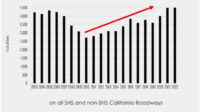Sonoma County will lift universal mask requirements for most indoor public settings beginning Wednesday, February 16, though unvaccinated individuals over age 2 will continue to be required to wear masks in all indoor public areas.
Additionally, businesses, venue operators and hosts may choose to continue to require all patrons to wear masks.
“Make no mistake: the pandemic is not over,” said Dr. Sundari Mase, Sonoma County’s Health Officer. “COVID-19 is still spreading twice as fast in our community today as it was during the peak of the delta surge last August. I strongly recommend people who face the greatest risk of illness — our seniors, essential workers and people with underlying health conditions — and the people who care about them to continue to wear their masks indoors in public settings.
Indoor masking is still required by the state for everyone, regardless of vaccination status, in public transportation; health care settings; congregate settings like correctional facilities and homeless shelters; long-term care facilities; and in K-12 schools and childcare settings.
Bay Area health officers, in alignment with the CDPH, continue to strongly recommend masks be used, especially crowded or poorly ventilated spaces. As evidence continues to show, vaccinations and boosters remain the best defense against the virus.
While wearing a mask indoors is no longer mandatory for people who are vaccinated, it remains a smart and simple way to protect yourself and the people around you, Mase said. All nine Bay Area counties will observe the updated policy.
The highly contagious Omicron variant brought on a new stage of the pandemic with a high number of new infections, but significantly fewer cases of life-threatening illnesses, especially for those who are vaccinated and boosted.
While relaxing indoor masking requirements is part of a population-level shift toward a “new normal” of living with the disease, Bay Area health officers advise that people continue to choose layered prevention strategies, such as wearing well-fitted masks (N95 or double layer cloth over surgical are best); staying home and testing when symptomatic; testing before gatherings; and improving indoor ventilation in situations where these strategies can add protection for themselves and others.
Staying up to date on vaccinations, meaning primary series and boosters when eligible, remains the most important way to prevent severe illness, hospitalization, and death.
After reaching a high on Jan. 10 of 248.7 cases per day per 100,000 residents, Sonoma County’s case rates have declined to 77.0 cases as Feb. 8. Hospitalizations, a lagging indicator of transmission spread, have also declined and never exceeded local capacity during the surge because of the county’s high overall rates of vaccination (79.4 percent) and boosters (61.6 percent), along with a local health order that temporarily restricted the size of large gatherings to prevent superspreader events during the peak of the surge.
For early education programs, such as preschool and childcare settings, CDPH continues to require masking for children older than age two. Vaccinations for children under 5 are currently undergoing federal review. Workplaces will continue to follow the COVID-19 prevention standards set by CalOSHA.
Some people may understandably feel anxious about these changes to masking requirements, officials acknowledged. “Community members who are vaccinated and choose not to mask should respect the choices of those who continue to mask.”Officials ask residents and visitors to be kind and respectful as people evaluate their risks and make choices to protect themselves and those around them.






Be First to Comment